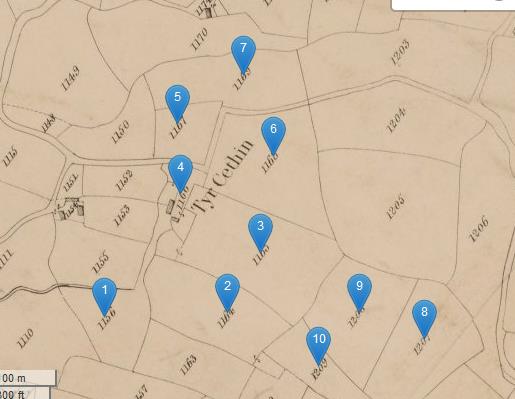
The surname Howell (often as Howells) is a fairly common one in North Gower and around Llanelli on the other side of the estuary. Unfortunately, parish records do not go back far enough for the connections between different Howell family groups to be traced. The Loughor parish registers that still exist begin in 1717, though there are bishop's transcripts for some of the years from 1678. Moreover, in Wales the practice of using surnames derived from the father's Christian name (e.g. John ap Hugh, becoming John Pugh) persisted until the 18th century, so even if earlier registers were available it might still have been difficult to establish relationships, Hywel (anglicised to Howell) being a common first name.
The earliest ancestor from whom I have been able to establish a line of descent is not actually in Loughor but in the marriage register of Llangunnor in Carmarthenshire, 25th June 1749: ‘Howell Howells of the Parish of Loughor Marine to Margaret Jones of the Same [?] in County of Glamorgan’. Llangunnor is a little to the east of Carmarthen. Their grandson William lived and farmed at Berthllwyd, and their great-grandson Griffith was the man who settled at Tŷ Cwm.
Tŷ Cwm is a house on a triangular plot of land on Cefn Stylle Road where the track to Cefn Stylle Farm branches off to the west. Cefn Stylle Road heads south from the B4295 road between Penclawdd and Gowerton and climbs through Banc-y-Cwm and the Wern (Wern-Olau on maps) to the Poundfallt in Three Crosses. Off it come lanes to Berthllwyd Farm, Llwyn-mawr and Cefn Stylle, where various inter-related families lived. See Cefnstylle map | Ty Cwm map
The Howell family of Tŷ Cwm walked down the road on weekdays to work, shop or go to school in Gowerton, and up on Sundays to Sunday School in the Wern or chapel in Capel-y-Crwys. It is just on the edge of the parish of Loughor, so it is in the Loughor parish registers that many Howell baptisms, marriages and burials are recorded. About 300 yards up the road a stream marks the boundary of the parish of Llanrhidian Higher, Swansea, which includes the Wern and Three Crosses. Llanyrnewydd Church in Blue Anchor was built as a chapel-of-ease in that parish, and that is where Ruth Howell's parents, Henry and Ann Thomas, are buried. One of the quirks that can make it hard to find the family in censuses is that although Loughor is in Glamorgan, it was recorded under Llanelly, Carmarthenshire, in most of the 19th century censuses.
When Tŷ Cwm was offered for sale in 2015 the estate agent, John Francis, described it as follows:
A former market garden detached extended five bedroom period property dating back to 1892. The property was extended back some 40 years to include a master bedroom at the rear of the property with balcony to enjoy the sweeping county views to the side. The land, of just under an acre, to which the property sits proudly in the centre, has a abundance of fruit trees and bushes to include, red and black currant, apple, pear, plum and raspberry, with mature trees,shrubs and plants. There is also a fresh water stream that runs to the front of the house.Located on Cefn Stylle, a road that joins Penclawdd toThree Crosses making it an ideal location to reach amenities, facilities and schools within the area and good link up to the M4 Corridor.
Griffith Howell lived in a cottage at Tŷ Cwm which he did not own, for it is not mentioned in his will. It is clear from the censuses that he was living there from 1861 to 1881. Tithe maps show that he was farming as a tenant a number of fields at Tir Cethin, a farm about a mile to the south west of Tŷ Cwm along a track that leaves Cefn Stylle above the Wern. He farmed about 30 acres, about half of which was pasture and half arable and meadow.
Tithe map name: Llanrhidian, Upper Division. Landowner: Nathaniel Cameron. Occupier: Griffith Howell
Tithe Map |Modern map

Map no |
Field no |
Name |
Usage |
Area |
Tithe Value |
1 |
1156 |
Wain Pwll |
Pasture |
2A 1R 4P |
2s 2d |
2 |
1164 |
Wain Pwll |
Pasture |
4A 2R 18P |
3s 6d |
3 |
1165 |
Cae Mawr |
Arable & meadow |
7A 4P |
18s 3d |
4 |
1166 |
Homestead &c |
Arable & meadow |
2R 20P |
3s 6p |
5 |
1167 |
Cae Llwyn Bach |
Pasture |
1A 3R 34P |
5s 5d |
6 |
1168 |
Cae Glas |
Arable |
5A 3R 10P |
13s 8d |
7 |
1169 |
Cae Llwyn Mawr |
Arable |
4A 1R 11P |
9s |
8 |
1207 |
Cae Cwm |
Pasture |
5A 1R |
9s |
9 |
1208 |
Cae Cwm Bach |
Pasture |
4A 2R 14P |
8s 8d |
10 |
1209 |
Wain Ucha |
Arable & meadow |
2A 1R 21P |
2s 10d |
Click here for Griffith's will
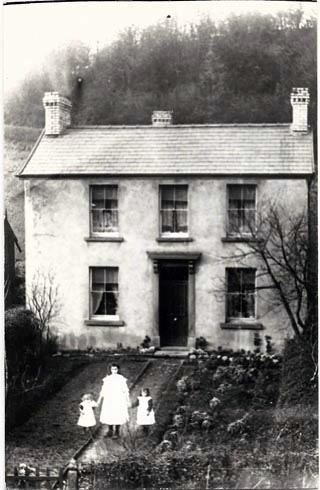 Griffith seems to have done well for himself, even though he characterises himself in that will as 'labourer'. In his will he leaves two houses in the Wern, one to his daughter Sarah, the other to his son Edward, to be divided equally between Edward's children after his death. In the 1891 census Griffith is a widower, living with his daughter in Cefnstylle or very nearby. This is the point at which Edward took over the lease on the Tŷ Cwm plot, apparently knocked down the old thatched cottage there, and built with his own hands the Tŷ Cwm that his descendants knew in the first half of the 20th century, using stone from the old building and probably some from the quarries nearby. The design of the house was simple and basic: the front door led directly to a narrow staircase up to the bedrooms. Downstairs on the right was the front parlour, used only for special occasions, to the left the family living room. A doorway at the back of the living room led to the back rooms, the scullery and pantry. I do not recall whether the scullery was a kitchen with a range, like at Hendrefoilan Farm, which was of a similar design, or whether cooking was done in the living room. Outside was a shed and privy. Upstairs were (I think) four bedrooms. They were needed, for the house and garden had to accommodate and provide for twelve children (plus two who died in infancy)! I was just too young to remember the legendary family gatherings on Boxing Day when the children and many of the horde of grandchildren would visit: my brother and sister remembered them well as very happy occasions.
Griffith seems to have done well for himself, even though he characterises himself in that will as 'labourer'. In his will he leaves two houses in the Wern, one to his daughter Sarah, the other to his son Edward, to be divided equally between Edward's children after his death. In the 1891 census Griffith is a widower, living with his daughter in Cefnstylle or very nearby. This is the point at which Edward took over the lease on the Tŷ Cwm plot, apparently knocked down the old thatched cottage there, and built with his own hands the Tŷ Cwm that his descendants knew in the first half of the 20th century, using stone from the old building and probably some from the quarries nearby. The design of the house was simple and basic: the front door led directly to a narrow staircase up to the bedrooms. Downstairs on the right was the front parlour, used only for special occasions, to the left the family living room. A doorway at the back of the living room led to the back rooms, the scullery and pantry. I do not recall whether the scullery was a kitchen with a range, like at Hendrefoilan Farm, which was of a similar design, or whether cooking was done in the living room. Outside was a shed and privy. Upstairs were (I think) four bedrooms. They were needed, for the house and garden had to accommodate and provide for twelve children (plus two who died in infancy)! I was just too young to remember the legendary family gatherings on Boxing Day when the children and many of the horde of grandchildren would visit: my brother and sister remembered them well as very happy occasions.
The house itself has, of course, been much extended and modernised. This photo (click on it to enlarge it) taken in about 1908 shows how it looked when it was comparatively new. The three girls are probably my mother, Violet, then aged about 3, Katie who was about 12, and Winifred, about 4, who died in 1908, though it could be Hilda (born 1906), Katie and Violet.
I don't know how long it took to build the house. Edward and Ruth married in 1882 and were living somewhere in Cefnstylle in the 1891 census. They are at Tŷ Cwm from the 1901 census onwards. Ruth came from Cwm Nant or Cerrig Mân, a farm to the west of Three Crosses and south of Llanyrnewydd Church, Blue Anchor. Edward worked at the Elba steelworks in Gowerton. My mother used to say that he was much respected there. In the 1930s recession when the company was in difficulties he persuaded his fellow workers to accept a pay cut that kept the company going and them in jobs. The management promised him a job for life in return. He was a deacon at Capel y Crwys, Three Crosses, and at some point founded a Sunday School in the Wern, which would have saved many of his children from one of the three long walks from Tŷ Cwm to Crwys that they would otherwise have done every Sunday. He was a parish councillor in Gowerton at one stage. My mother always spoke of him with affection, and even more of her mother, the gentle, kindly Ruth, who must have been an extraordinary woman to bring up 14 children and lose only two of them in those days when child mortality was very common. My paternal grandmother in Dunvant, by contrast, lost five of her eight.
The family was Welsh-speaking. The 1901 census records them all as bilingual except 4-year old Jack, then the youngest, who spoke only Welsh. Going to school in Gowerton, as they all did, must have been very tough for them all at the start, for English was the only language used in school.
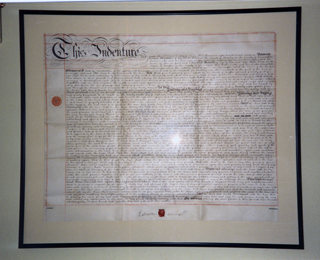 I do not know when piped water and electricity came to Censtylle. I guess that water was at first drawn from the stream. As far as I recall from the 1940s there was electricity there then, though maybe not in all rooms. I remember staying a night with my cousin Aubrey, son of George & Winnie, down the road in Llwynmawr Lane about 1950 and they still used candles in the bedroom though there was electricity downstairs.
I do not know when piped water and electricity came to Censtylle. I guess that water was at first drawn from the stream. As far as I recall from the 1940s there was electricity there then, though maybe not in all rooms. I remember staying a night with my cousin Aubrey, son of George & Winnie, down the road in Llwynmawr Lane about 1950 and they still used candles in the bedroom though there was electricity downstairs.
This copy of an indenture (click on it to enlarge it) signed by Edward Howell is very difficult to read. I don't know if a good transcription of it is available anywhere. It provides permission to use and build on the land using materials already there. The landowner is a farmer, Evan Thomas, of Glanlliedi Farm, which is at Felinfoel, near Llanelli. The indenture gives Edward and his heirs a lease for 99 years from 25th March 1891 on payment of ground rent.
These photos were taken in about 1991 when Tŷ Cwm was 100 years old and the occupants invited family members to see it. (Click on each to enlarge it.)
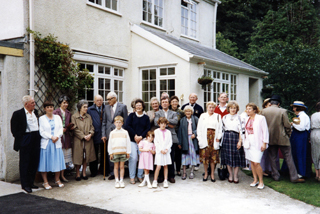 Includes 3rd from the left Mary, Peggy, someone, Bob; Morley at the back to left of hanging basket; front right Margaret, Elaine, Derrin
Includes 3rd from the left Mary, Peggy, someone, Bob; Morley at the back to left of hanging basket; front right Margaret, Elaine, Derrin
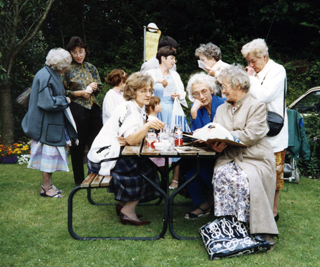 Around the table: Elaine, Thelma, Megan (?), Margaret behind
Around the table: Elaine, Thelma, Megan (?), Margaret behind
After Edward's death in 1947 his unmarried son Jack, the only one left at home, continued to live in the house. Edward had left his property to be divided equally between the twelve children, so Jack bought out the shares of his siblings. Apart from a few mementoes (in my mother's case a matching pair of nearly the smallest brass candlesticks from a great double set in ascending sizes that once graced the mantelpiece at Tŷ Cwm) most of the contents stayed at Tŷ Cwm with Jack. However, to everyone's surprise he married five years later at the age of 56. When he died five years after that all of the family heirlooms went to Margaret, his wife, and she sold the house.
Many of the descendants of Edward and Ruth continued to live very nearby. The house in the Wern that Edward inherited from his father eventually became the home of his daughter Jane and her family, the Harrieses. Sarah was in Three Crosses; Mary Ann and the Tuckers further down Banc-y-Cwm in a house still owned by Colin, her grandson. (Morley, a grandson of Edward and Ruth lives next door.) Three other children of Edward and Ruth lived in Gowerton: Emily, Rhys and Hilda, whilst Bob was not far away in the opposite direction in Penclawdd.
The ones who moved away were: Katie (Cockett), Maggie (Blackpill), Vi (Tycoch), Gladys (Morriston).
The 1915 Ordnance Survey map shows a mineral railway running past Tŷ Cwm on the other side of the road. It would probably have carried coal from the Cefngolau No 1 Colliery (opened 1902) in the Wern to Gowerton. I have no memory of it being there and don't know when it became redundant—probably when the colliery closed in 1922. Elaine recalls that the line crossed the road just above Tŷ Cwm and that Kingsley's friend Emlyn, who farmed at Cefn Stylle, sold lorry loads of waste slack coal from there, which enabled him to buy Llwyn Mawr Farm. See the OS 25" map Revised 1913 and scroll about and enlarge for a very detailed view of the whole valley. See the Welsh Coal Mines page for a lot of information about about the mines that worked the coal seam that ran from Blackpill to Berthlwyd.
Ruth Thomas was born and brought up at either Cwmnant (her parents' address in the 1871 census) or Cerrig Mân (according to a newspaper cutting about Edward & Ruth's Diamond Wedding), a farm to the west of Three Crosses and south of Llanyrnewydd Church, Blue Anchor (see map, close the Help window and pan left). Her father Henry was a gamekeeper at Alltwen and latterly a farmer of 60 acres. He's not in the 1861 census, unfortunately, which should show Ruth at home with her parents). His father, another Henry, was a weaver ("Thomas the Gwaidd") who lived at Tanyrhiw, just three houses away from Tŷ Cwm to the north. It was no doubt this proximity that allowed Edward and Ruth to meet when she visited her grandparents. The 1881 census lists her in her grandparents' house as though she were living there, which she very well might have been.
The Thomases, who came originally from Llandeilo, were a large family. The earliest I can find is Rees Thomas, born 1779. In his old age, as a widower, Henry jnr went to live with his daughter, Sarah, who was married to a butcher and farmer, Thomas Evans of Trafle Farm, Gowerton.